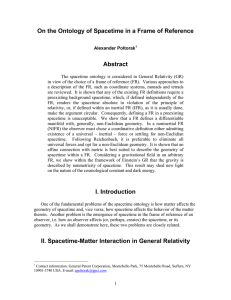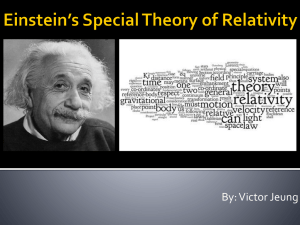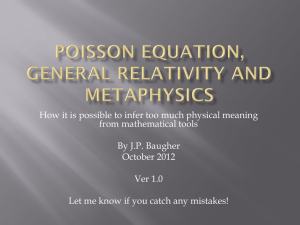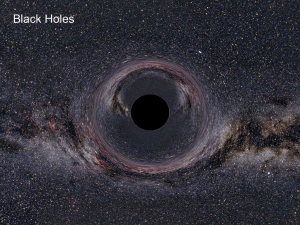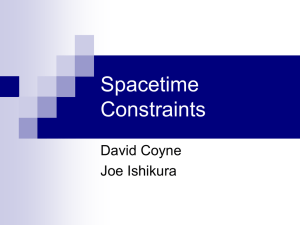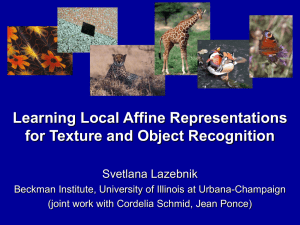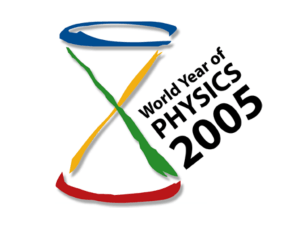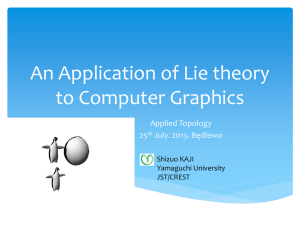On the Spacetime Ontology in a Frame of Reference - PhilSci
advertisement
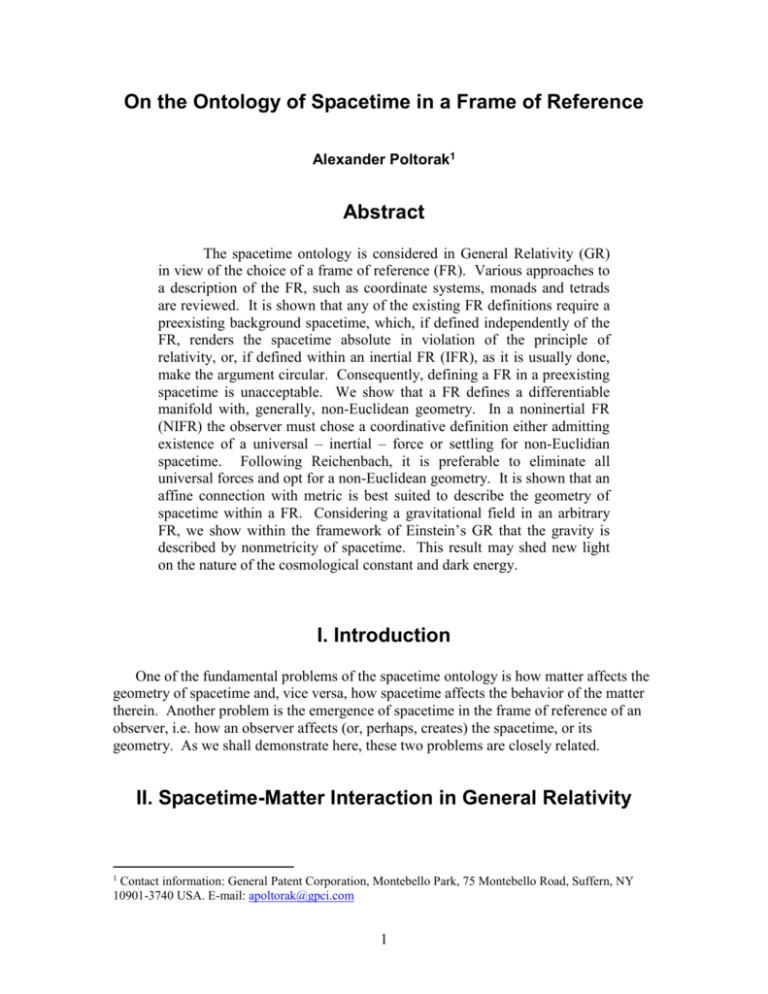
On the Ontology of Spacetime in a Frame of Reference
Alexander Poltorak1
Abstract
The spacetime ontology is considered in General Relativity (GR)
in view of the choice of a frame of reference (FR). Various approaches to
a description of the FR, such as coordinate systems, monads and tetrads
are reviewed. It is shown that any of the existing FR definitions require a
preexisting background spacetime, which, if defined independently of the
FR, renders the spacetime absolute in violation of the principle of
relativity, or, if defined within an inertial FR (IFR), as it is usually done,
make the argument circular. Consequently, defining a FR in a preexisting
spacetime is unacceptable. We show that a FR defines a differentiable
manifold with, generally, non-Euclidean geometry. In a noninertial FR
(NIFR) the observer must chose a coordinative definition either admitting
existence of a universal – inertial – force or settling for non-Euclidian
spacetime. Following Reichenbach, it is preferable to eliminate all
universal forces and opt for a non-Euclidean geometry. It is shown that an
affine connection with metric is best suited to describe the geometry of
spacetime within a FR. Considering a gravitational field in an arbitrary
FR, we show within the framework of Einstein’s GR that the gravity is
described by nonmetricity of spacetime. This result may shed new light
on the nature of the cosmological constant and dark energy.
I. Introduction
One of the fundamental problems of the spacetime ontology is how matter affects the
geometry of spacetime and, vice versa, how spacetime affects the behavior of the matter
therein. Another problem is the emergence of spacetime in the frame of reference of an
observer, i.e. how an observer affects (or, perhaps, creates) the spacetime, or its
geometry. As we shall demonstrate here, these two problems are closely related.
II. Spacetime-Matter Interaction in General Relativity
1
Contact information: General Patent Corporation, Montebello Park, 75 Montebello Road, Suffern, NY
10901-3740 USA. E-mail: apoltorak@gpci.com
1
The classical General Relativity Theory (GRT) offers the following answers to the
above stated questions:
1. The matter (and nongravitational fields) affect the metric g of the Riemannian
space (V4) by way of the Einstein field equation G=8πT or in coordinate
representation:
G R
1
Rg 8 T
2
(1)
where G (in a local chart x, Gμν) is the Einstein curvature tensor and T (Tμν) is the
energy momentum tensor of matter and all nongravitational fields, Rμν is the Ricci
tensor, R is the scalar curvature and gμν is the metric tensor. We use here
geometrical units, in which Newton’s gravitational constant and the speed of light
constant c are set to a unity.
2. The test particles move along the geodesic lines of Riemannian space, which are
defined by the Levi-Civita (metric) connection Γ of V4: xX = 0, or in a local
chart x
d 2 x
dx dx
0
ds 2
ds ds
(2)
where is a covariant divergence with respect to the Levi-Civita connection Γ
( ) and τ is an affine parameter on the curve which we can take to mean proper
time.
3. A frame of reference (FR) is represented by a coordinate system. An inertial
frame of reference (IFR) is represented by a global Lorentz coordinate system
while a noninertial frame of reference (NFR) is represented by a curvilinear
coordinate system, which is locally Lorentz. Thus the principle of relativity,
which initially was thought to be the cornerstone of GR, is reduced in GRT to a
self-evident requirement of general covariance with respect to coordinate
transformation.
In other words, Einstein’s GR describes how matter curves spacetime by affecting
its metric, which in turn, through metric-compatible connection, tells matter how to move
([1,] p. 5).
Clearly, GRT reduces frames of reference to coordinate systems, which play little
role if any in the geometry of spacetime. This position is untenable because coordinate
systems have no physical meaning whatsoever, while the frame of reference is a
fundamental physical concept – a prism, as it were, through which the world is perceived
by an observer. A particular choice of a FR affects the physical laws therein.
2
As it has been pointed out by Kretschman [2], Fock [3,4], Wigner [7], Rodichev
[8,9,10,11,12] and numerous other authors, including this author [27,28], the coordinate
system is merely a way to number points of spacetime. Akin to street names and building
numbers in a city, the coordinates are at best a convenience device. ([1,] p. 6-8). Any
coordinate transformation affects the physics of spacetime no more than renaming a street
or renumbering the houses on that street affects the life of people who live therein. As
Ohanian and Ruffini put it, “From a mathematical point of view, the covariance principle
is therefore seen to be a triviality.” ([13], p.373) We can well formulate both the
geometry of spacetime and the physics in a given spacetime in the coordinate-free
language of contemporary mathematics. (For example, the Einstein equations (1) as well
as the equations for geodesic lines (2) above are given both coordinate and coordinatefree form.) Notwithstanding the obviousness of these arguments, the erroneous notion
that coordinate systems describe reference frames stubbornly persist.
III. Spacetime in a Frame of Reference
A frame of reference, on the other hand, is one of the most important concepts of
physics. Moreover, the epistemological importance of a reference frame cannot be
overstated. One can say nothing about the state of a physical system in mechanics or
field theory until one specifies the frame of reference in which said system is observed.
Moreover, as Reichenbach pointed out [14], even the geometry of spacetime remains
undetermined until we choose our coordinative definitions, such as the unit of length and
the congruence of the standard units. It is the observer in a NIFR that can choose to
entertain inertial (“universal”, according to Reichenbach) forces or set them to zero, as
recommended by Reichenbach, thereby forcing non-Euclidian geometry of the spacetime
[14].
Various observations conducted by different observers can only be compared if
the reference frames of these observers are known along with laws of transformation,
such as the Galilean transformation of the Newtonian mechanics, the Lorentz
transformation for the IFR in special relativity, and yet to be determined transformations
for the NIFR.
1. Problem of Measurement and Dimensionality of Space
A reference frame plays an important role in a measurement problem bearing
upon the question of dimensionality of our space. The latter question cannot be resolved
until it is clarified whether the space in question is a conceptual mathematical space or an
empirical physical space. If Minkowski spacetime is viewed as a mathematical space, its
4-dimensionality presents no problem and merely signifies that we need four numbers
(three spatial coordinates and a moment in time) to describe an event. As each physical
event is characterized by some energy value, it is only logical to assign this value as the
fifth coordinate. Moreover, the knowledge of the spatial coordinates of a test particle in a
given moment is not enough to predict its motion, which requires also the knowledge of
3
the velocity. Why not then add three more coordinates corresponding to the three
components of the velocity vector to the description of each point, raising the
dimensionality of spacetime to seven! In fact, configurational or parameter spaces of 6n
dimensions (n – number of particles) is routinely used in physics (let alone Hilbert space
with its infinite number of dimensions used in quantum mechanics). Yet all of these
constructs are well founded and legitimately used as a conceptual space.
To discuss the dimensionality of the physical space, we must first define what we
mean by physical space. In contrast to conceptual mathematical space, physical space is
defined as empirical space whose geometry is determined by measurement.
Consequently, the dimensionality of physical space must be demonstrable by our ability
to directly measure such space. It is easy to see that we can directly measure the volume
of space of no higher dimension than three. We use rods to measure linear length (onedimensional space); we can use standard squares or triangles to measure the area (twodimensional space); we can also use standard cubes to measure the volume (threedimensional space). But we cannot in principle construct a “standard event” to measure
the volume of Minkowski spacetime. This seems to indicate that the physical space is
three-dimensional.
The problem now arises how to convert four-dimensional quantities of Special
Relativity, which can never be observed or measured directly into the observable threedimensional objects. This can only be done in a given reference frame. Whatever the
definition of the frame of reference, it must include a reference body wherein the
measurement devices are situated. The worldline of this reference body is uniquely
represented by its velocity 4-vector τμ: τμ = dxμ/ds, τμ τμ = 1. This vector field can be
used to obtain time-like and space-like observables in a tangent space. Thus, the time
interval in this frame of reference is defined as
dt dx
(3)
b g
(4)
If gμν is the metric tensor, then
is orthogonal to τμ: τμ bμν = 0 and can be used as an operator of projecting fourdimensional objects onto a three-dimensional space-like hypersurface orthogonal to time.
The metric can now be defined in terms of physical time and space intervals as
ds 2 dt 2 dl 2
(5)
where dl2 = bμνdxμdxν. According to this so-called τ-field approach [15,16,17,18,19,20],
any 4-vector Aμ can be decomposed into observable time and space components: a=Aμτμ
and aμ=Aνbμν.
4
These physically observable quantities can only be obtained in a frame of
reference and are only meaningful in this frame, which further underscores the
epistemological significance of the frame of reference.
2. What is a Frame of Reference?
A. Evolution of the Frame of Reference Concept
Let us briefly review the evolution of the concept of the frame of reference. In
Newtonian mechanics, reference frames play a very important role although the concept
is not rigorously defined. It is implicitly understood the a frame of reference is
comprised of a reference body, which is taken to be a rigid body, with a Cartesian
coordinate system and a clock rigidly attached to the reference body. Galilean
transformations supply the laws of transformation between IFRs. The IFR is defined as a
FR whose reference body is the state of rest or inertial movement, i.e. free from any
forces. This definition, of course, is an idealization as we can never be sure that the
reference body is free from any forces. Einstein questioned whether there exists an
inertial frame of reference. [21,22]. This concept can rather be defined as an
approximation wherein the measured deviation from the second law of Newton is less
than the measurement error, i.e., it is undetectable ([23], p.58). Einstein considered
General Relativity as a theory that did away with the notion of the IFR, which he
considered one of the greatest accomplishments of this theory.
The NIFR are dealt with in Newtonian mechanics by adding an ad hoc term to the
second law of mechanics, which describes the inertial forces, such as centrifugal or
Carioles forces.
In Special Relativity, the concept of the frame of reference undergoes a
substantial revision by way of combining space and time into a unified spacetime
continuum called Minkowski space (which is a pseudo-Euclidean space) with the
resulting replacement of the Galilean transformation by the Lorentz transformation. The
Theory of Special Relativity is a relativistic theory of IFR and it does not explicitly
address the NIFR. Attempts, however, have been made to utilize Special Relativity for
description of specialized NIFR (see, for example, [1], pp 163-176 and [23], pp 9-13).
For a FR with uniform acceleration, this description leads to a hyperbolic movement in
Rindler space severely limited by the event horizon. To quote MTW, “It is very easy to
put together the words ‘the coordinate system of accelerated observer’…if taken
seriously, they are self-contradictory.” ([1], p.168)
B. Coordinate Systems
It was in search of the description of NIRF that Einstein turned to curvilinear
coordinate systems replacing the Lorentz transformation with a general coordinate
transformation. The requirement of general covariance, which should be a minimal
5
requirement for any mathematical model purporting to describe some aspect of physical
reality, was elevated to the exalted status of Principle of General Relativity.
As Rodichev pointed out ([9], p.287), even in Newtonian mechanics the
transformation from one frame of reference to another is described by the fully covariant
equation
r(t) = a(t) + r'(t),
t = t'
(6)
where 3-vectors r and r’ denote the position of a test particle in IFR and NIFR,
respectively. Obviously, this expression does not depend on the choice of the coordinate
system.
It may be one of those curious cases in the history of science when a wrong idea
led to one of the most beautiful theories – General Theory of Relativity. Kretschman was
the first to realize that the principle of general covariance had nothing to do with general
relativity and has no physical and very little geometrical meaning [2]. Einstein seemed to
agree with this criticism but noted that, “Even though it is true that one must be able to
bring every empirical law into general covariant form, yet the Principle [of general
covariance – AP] has considerable heuristic force, which proved itself in the problem of
Gravitation.” (see [13], p.373). The only physical (or, rather, topological) meaning
coordinates have is that they reflect the dimensionality of physical space ([20], p.67).
In contemporary approaches, the reference frame is identified with a local or
global chart on a differentiable manifold. The transformation from one reference frame
to another is accomplished by a general coordinate transformation on V4, which Rodichev
calls transformation of group A having physical meaning of the grading of the
measurement scale [9,10,11].
Attempts have been made to separate those coordinate transformations that are
time dependent. Such transformations are thought to be suitable to the description of the
transformation from one FR to another. In truth, it is nothing more than a time-dependent
scheme to number the points of the manifold, which, of course, has nothing to do with the
physical motion of the reference body. The fallacy of this approach, if it is not selfevident, has been convincingly demonstrated by Rodichev [9,10,11,12]
Unfortunately, many elegant schemes to describe the frame of reference by
making use of chronometric and kinemetric invariants at the end of the day fall into the
same trap of mistaking a time-dependent numbering scheme for the real reference frame
transformation.
The ultimate argument in this debate is that the inertial force arising in any NIFR
is a true vector. Obviously, in an IFR the inertial force is zero. However, if a vector is
equal to zero in one coordinate system, it is equal to zero in all coordinate systems, and if
it is not zero in one coordinate system, it is not zero in all coordinate systems.
Consequently there exists no coordinate transformation that can transform a zero vector
6
in an IFR into a non-zero vector in a NIFR. This conclusively proves that coordinate
transformation cannot describe a transition from an IFR to a NIFR.
C. Monads or τ –Field
The monad or so-called τ-field approach has been already described above when we
discussed the problem of measurement. It aims to separate space and time from the
spacetime continuum to obtain physically observable quantities. The foundation of this
approach rests on the representation of the FR as a congruence of worldlines of various
points of the reference body associated with the given FR. This congruence of the
worldlines is invariant with respect to the general coordinate transformation (Group A)
and can be represented by the vector field of 4-velocities tangent to these worldlines – the
τ-field.
Unfortunately, further conditions applied to the τ- field, such as respectively socalled chronometric [17] and kinemetric [25,26] conditions:
g 0
g 0
,
g 00
g 00
(7)
spoil the invariant nature of the τ- field.
An even more serious difficulty of this approach is that it describes the FR by the
field of 4-velocities of its reference body measured in another (presumably inertial) FR.
This circular definition is characteristic of most approaches to reference frames. Since
the observer in a given FR cannot measure his own τ-field, as he is at rest with respect to
the reference body, i.e., the τ-field is identically zero for this observer everywhere, it is of
little use to the observer.
D. Tetrads
In this approach the frame of reference is identified with the set of four vectors
{e0, e1, e2, e3} defined in any given point of the differentiable manifold, called a tetrad.
The tetrad, which is a special case of Cartan’s repère mobile, is an infinitesimal
coordinate system defined by the four linearly-independent vectors e(i)μ, where (i) is the
number of the vector and μ is the regular tensor coefficient denoting a particular
component of this contravariant vector in a local chart. Usually the tetrad is comprised of
the basis vectors orthogonal to each other, in which case the tetrad is called orthonormal.
The 0th vector of the tetrad, e(0)μ, is usually selected to be tangent to the worldline of the
observer, in which case it is the timelike 4-velosity vector of the reference body.
e(0)
7
dx
ds
(8)
The tetrad is invariant with respect to the general coordinate transformation
(Group A). The transition from one reference frame to another is described in this
approach by the tetrad transformation (Group B):
e(i ') ((ik'))e( k )
(9)
There are different interpretations of the physical meaning of the tetrad.
According to Rodichev ([9], p.300), a tetrad defines the three Euler angles and the
velocity of the center mass, six values in total. According to others ([20], p.72), the
additional degrees of freedom describe the spin of the particles forming the reference
body.
This tetrad moves along the worldline of the observer by means of the FermiWalker transport. This preserves the orthogonal orientation of the timelike vector of 4velocity to the other three spacelike vectors of the tetrad.
The tetrad transformation (Group B) does not change any of the physical vectors
of the basis. It only changes the initial values for the velocity of the center-mass and
three Euler angles. As these values could be selected arbitrarily, Group B transformation
has as much physical meaning as Group A coordinate transformation and, consequently,
cannot describe physical transition from one FR to another. Thus the laws of physics
must be invariant with respect to Group B transformation as they must be invariant with
respect to Group A coordinate transformation.
The invariant tetrad field approach, albeit the most comprehensive, appears to be
overkill. It is hardly reasonable to suppose that a reference body of a FR consists of a
plurality of particles, each having its own velocity, acceleration, spatial orientation, etc.
In our view, only one such particle, or a rigid body made of many particles which all
move in unison, can be considered as a reference body and define the FR. The motion of
all other particles would have to be considered as moving with respect to this FR.
E. Definition
A physical definition of a FR has to include the following elements:
An observer
A reference body
A standard of length
Gyroscopes
A clock
An accelerometer
An observer, who plays a very important role in quantum physics, is usually omitted
from consideration in Newtonian or relativistic mechanics. Yet the observer, as we will
8
show, plays a crucial role in classical physics as well – without a coordinative definition
that is a free choice of a conscious observer the geometry of nature is indeterminable, as
Reichenbach has demonstrated [14].
As we pointed out before, it is not reasonable to allow a reference body to be a
plurality of independent particles each having its own velocity, acceleration, spatial
orientation, etc. We require that a reference body be a single rigid body, such as a
laboratory or a spacecraft. All other objects not rigidly connected to the reference body
will be considered moving with respect to this FR.
An observer in any FR will need a rigid rod as a standard of length, such as meter; he
will require gyroscopes to set physical directions in space and to detect a possible rotation
of the reference body rendering this FR noninertial; he will require a clock to measure his
proper time and an accelerometer to detect possible acceleration that would also render
the FR noninertial.
A necessary condition is that all of these elements be rigidly connected to the
reference body, i.e. be immobile with respect to the walls of the laboratory or the
spacecraft.
F. Mathematical Representation
It is clear that the observer in a given FR defines his or her own manifold. We
will assume that it is differentiable manifold – a four-dimensional spacetime continuum.
With each FR defining its own manifold, the question arises as to the correlation between
such manifolds. A faith in the objective existence of the physical world would lead us to
believe that these manifolds are homeomorphic. However, we must remember that an
event perceivable in one FR may not necessarily be perceivable in another if it lies
outside its event horizon. Rindler space is a well-known example of such a possibility
([23], p.11). Having noted that, for simplicity, we will consider the manifold generated
by the chosen FR to be the common differentiable manifold for all FRs subject to the
limitations of their peculiar event horizons. This simply means that all observers observe
the same events albeit from their peculiar vantage point – FR.
Each individual FR will generate its own geometry on this differentiable
manifold. The question remains: how does a particular FR generate a geometric structure
on the differentiable manifold? Referring to our physical definition of the FR given
above, we see that the length standard which allows the observer to measure the distance
between two points sets up the metric g on the manifold. To define parallel transport of
vectors, which is essential, an affine connection Г is required. Fortunately, it is naturally
generated in any FR. As we observe the trajectories of free-moving test particles and
require these trajectories to be geodesic lines of the spacetime defined by the chosen FR,
such geodesic lines define the affine connection. Indeed, a freely moving test particle in
an IFR moves along a geodesic line of Minkowski space:
9
d 2 x
dx dx
0
d 2
d d
(10)
where is a flat Levi Civita connection of Minkowski space and τ is an affine parameter
along this line.
In this IFR a reference body accelerating with acceleration a moves along a
worldline
d 2 x
dx dx
a
2
d
d d
(11)
In the accelerating NIFR a test particle moves in the opposite direction with
acceleration –a:
d 2 x
dx dx
a
2
dt
dt dt
(12)
Determined to eliminate the universal forces the observer in the NIFR demands
that this trajectory represent the geodesic line of a non-Euclidean space:
d 2 x
dx dx
0
dt 2
dt dt
(13)
where is an Affine connection on the differential manifold and t is an affine parameter
along this line.
Since the two expressions (12) and (13) represent the same trajectory of the test
particle, we can subtract (12) from (13) to obtain
T
dx dx
a
d d
(14)
where
T
(15)
is called affine deformation. If ημν is the Minkowski metric tensor, we can choose
T a
(16)
At this point there is no motivation to impose a Riemannian requirement that the
covariant derivative of the metric vanishes identically and, therefore, the metric and the
connection remain totally independent. Hence we have the geometric structure of the
10
space of affine connection with an independent metric, sometimes called Weyl space W4
or (Ln,g)-space. The affine connection has the form:
(17)
It is easy to see that Minkowski metric η is inhomogeneous with respect to the
affine connection Γ, i.e. its covariant derivative with respect to this connection does not
vanish: hμν;λ ≠ 0, where the semicolon denotes a covariant derivative with respect to the
affine connection Γλμν. Generally, the affine deformation Tλμν is comprised of the
symmetric tensor of nonmetricity Qλμν and anti-symmetric torsion tensor Sλμν:
T S
Q
(18)
As it is known, torsion does not affect the geodesics, i.e. two affine connections different
only by torsion have the same geodesics. Thus, for our analysis, we can disregard torsion
and assume that affine connection Γλμν is symmetric in its two lower indexes:
(19)
and, therefore, the tensor of affine deformation is equal to the tensor of nonmetricity:
T Q
(20)
The tensor of nonmetricity can be expressed through the covariant derivatives of
the metric tensor η as follows:
Q
1
2
(21)
It is important to note that our approach to definition of NIFR does not suffer
from the circularity of argument as many other approaches, such as coordinate systems or
monads, do. Indeed, the equations (10) and (11) were only used for illustration purposes
and are not essential to the argument. Since an observer in a NIFR can measure the
acceleration of test particles in his reference frame directly (and can measure the
acceleration of his reference body by use of accelerometers and gyroscopes) we may start
directly from the equation (12) where the acceleration a is measured within the NIFR and
the choice of connection (flat Levi-Civita connection of Minkowski space or affine
connection Γ of Weyl space) is a mater of coordinative definition. Each can be chosen
within the NIFR and we do not need an IFR to define a NIFR.
We can derive from this analysis the following conclusion:
a. The spacetime in a frame of reference is generally a Weyl space W4 with
independent affine connection Г and inhomogeneous metric η.
11
b. In an IFR where nonmetricity vanishes the affine connection is a trivial
(flat) Levi-Civita connection compatible with the Minkowski metric η.
c. In a NIFR the affine connection Г has curvature; however, this curvature
is due to the nonmetricity of this connection.
d. Any two FRs share the same metric but have different affine connections.
e. A transformation from an IFR to a NIFR or from one NIFR to another
amounts to affine deformation of connection.
3. General Relativity in a Spacetime with Affine Connection and
Metric
In 1980 [27], we proposed that the frame of reference is described by a
differentiable manifold with an affine connection and metric g. We showed that a
Levi-Civita connection Г can be decomposed into its affine and nonmetric Q
components: Q . (Note that in this section we reverse the notations for LeviCivita and affine connection to make the notation compatible with GR.) This in turn
leads to a unique decomposition of the Riemannian curvature and Einstein’s curvature
tensors into the sum of affine and nonmetric components:
R = R+R
(22)
G = G +G
where R is the Riemannian curvature tensor, R is its affine component and R is its
nonmetric component; and G is the Einstein tensor:
G R
1
Rg
2
(23)
G R
1
Rg
2
(24)
G R
1
Rg
2
(25)
G is its affine component:
and G is its nonmetric component:
This decomposition allowed us to recast the Einstein gravitational field equations
in a form invariant with respect to the arbitrary choice of a FR:
R
1
1
Rg Rg 8 T R
2
2
(26)
We see that in sharp contrast with General Relativity, where gravity is described
by the metric, in this equation gravity is represented by nonmetricity (tensor of
nonmetricity Q plays the role of the strength of the gravitational field). It is important to
12
stress that this is not an alternative theory of gravitation. The field equation (26) was
obtained from the standard Einstein field equation. We merely separated the contribution
of the inertial forces from the gravity by fixing the affine connection representing a
chosen frame of reference.
We can make two interesting observation about equation (26): (a) the scalar
curvature of the affine connection plays the role of a cosmological constant and (b) the
Ricci tensor of the affine connection contributes to the energy-momentum tensor T as an
additional field source. This is not at all unexpected. The inertial forces existing in a
NIFR have energy and therefore must contribute to the gravitational field. What is
noteworthy is that these inertial forces are repulsive forces (akin to the centrifugal force)
and counteract the attractive pull of the gravitational forces. Therefore, the inertial forces
accelerate the expansion of the universe. The experimental fact of the accelerated
expansion of the universe may suggest that we are observing the universe from a NIFR.
This may be an indication that the mysterious repulsive dark energy pervading the
universe is but a field of inertial forces arising out of the noninertial frame of reference in
which we see our world. Whether or not this explanation proves satisfactory, it’s very
possibility underscores the extraordinary importance frames of reference play in the
ontology of spacetime.
IV. Conclusion
As we have shown, various existing approaches to the description of frames of
reference are unacceptable as they rely on circular logic or preexistent absolute space. A
new mathematical model of a reference frame was proposed based on a differential
manifold with an independent affine connection and metric, i.e., so called Weyl W4or
(Ln,g) space. The affine connection is determined by observation of the trajectories of
free-moving test particles. It is the role of the observer in any given frame of reference to
choose coordinative definitions that eliminate such universal forces as gravity and
noninertial forces thereby opting for a non-Euclidian geometry. The transformation
between various reference frames is described as affine deformation.
Fixing a reference frame of an observer leads to a novel view of the spacetime in
GR as affine connection geometry with independent metric wherein the gravity is
described as nonmetricity of the spacetime. Incidentally, this approach leads to a fully
covariant theory of gravitation and the solution of the Energy Problem in GR [28]. It is
suggested that this approach may prove fruitful in explaining the nature of the
cosmological constant and dark energy in terms of inertial forces.
References:
1. C. Misner, K. Thorne, J. Wheeler. Gravitation. Freeman, San Francisco, 1973.
13
2. E. Kretschman, Über den physikalischen Sinn der Relativitätspostulate. A.
Einsteins neue und seine ursprungliche Relativitätstheorie, Ann. Physik, 53 (1917)
575-614.
3. V. A. Fock, The Theory of Space, Time and Gravitation, Pergamon, Oxford,
1959.
4. V.A. Fock, Basic Principles of Einstein’s Theory of Gravitation, in the
Proceedings of the Second Soviet Conference on Gravitation, Tbilisi 1967, pp 58.
5. D.W. Siama, J. Math. Phys. 2, 472 (1961).
6. D.W. Siama, Ann. D. l’Inst. H. Poincaré 17, 1 (1961).
7. E.P .Wigner, Events, laws of nature, and invariance principles, Nobel Lecture,
December 12, 1963 (see http://www.nobel.se/physics/laureates/1963/wignerlecture.pdf)
8. V.I. Rodichev, On Tetrad Theory of Gravitation, in the Proceedings of the Second
Soviet Conference on Gravitation, Tbilisi 1967, pp 71-96
9. V.I. Rodichev, Einstein’s miscellaneous (Nauka, Moscow, 1968), p 115 (in Russ.)
10. V.I. Rodichev, Geometrical properties of frames of reference. Einstein’s
miscellaneous, 1971. (Nauka, Moscow, 1972), pp. 88-113 (in Russ.)
11. V.I. Rodichev, Evolution of the Frame of Reference Concept and the Einstein’s
Program, Einstein’s miscellaneous, 1974. (Nauka, Moscow, 1976), pp. 286-334
(in Russ.)
12. V.I. Rodichev. Theory of Gravitation in Orthogonal Tetrads. Nauka, Moscow,
1974. (In Russ.)
13. H. Ohanian and R. Ruffini, Gravitation and Spacetime, Norton, New York, 1976.
14. H. Reichenbach, The Philosophy of Space & Time, Dover, New York, 1958.
15. C. Eckart, Phys. Rev., 1940, 58, 919.
16. B. Lief, Phys. Rev., 1951, 84, 345.
17. A.L. Zelmanov, Proc. Acad. Sci. of the USSR, 1948, 61, 993; 1956, 107, 815;
1960, 135,1367.
18. C. Cattaneo, Nuovo Cimento, 1958, 10, 318.
19. E. Schmutzer, Relativistische Physik, Leipzig, 1968.
20. N.V Mitzkevich, Reference Frames and Constructivist Approach to Observables
in General Theory of Relativity, Einstein’s Miscellaneous 1971, Nauka, Moscow,
1972. (In Russ.)
21. A. Einstein, L. Infeld, The Evolution of Physics, Growth of Ideas from Early
Concepts to Relativity and Quanta, Simon and Schuster, NY 1942, ch 3.
22. A. Einstein, The Meaning of Relativity, Princeton University Press, Princeton,
NY, 1945
14
23. G. ’t Hooft, Introduction to General Relativity, Rinton Press, New Jersey, 2001.
24. Yu. S. Vladimirov, Weak Spherical Gravitational Waves, Theory of Relativity and
Gravitation, Nauka, 1976, ff 26-44 (in Russ.)
25. Yu. S. Vladimirov, V.I. Antonov, Acad. of Sci. of Ukraine, Kiev (1972) ITF-72137R; III Soviet Gravitational Conference Proceedings, Erevan (1972), f 199 (in
Russ.)
26. A.L. Zelmanov, Proc. Acad. Sci. of the USSR, 1973, 209, 822.
27. A. Poltorak, 9th International Conference on General Relativity and Gravitation,
Abstracts, Jena, Vol. 2, 516, 1980. (Available on http://arXiv.org/abs/grqc/0403050)
28. A. Poltorak, 10th International Conference on General Relativity and Gravitation,
Padova, Contributed Papers, Ed.: B. Bertotti, F. de Felice, A. Pascolini. Vol.1, p.
609, 1983 (Available on http://arXiv.org/abs/gr-qc/0403107)
15
